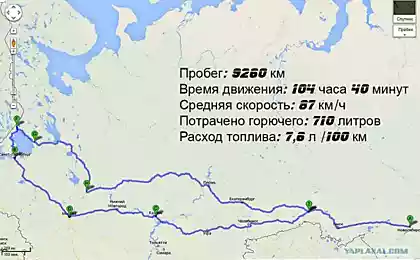893
Cities change the temperature in the range of thousands of kilometers around

Even if you live at a distance of 1, 5 km away from the big city, it affects the weather in your neighborhood
The goal of the new study - to examine how human activity affects the environment. Scientists came to the conclusion that the heat generated by human activities in the city, changes the nature of high-speed streams of wind and other main components of atmospheric systems. Civilization activity affects the temperature within a radius of thousands of miles, essentially heating some areas, while others - cooling, according to a study published in Nature Climate Change.
Excessive "discarded heat" that comes from buildings, vehicles and other sources in the territories of the largest cities in the Northern Hemisphere is warming winters over large areas of North America and North Asia.
The impact of cities on global mean temperature is almost imperceptible: the average temperature increase across the world is only 0, 01 degrees Celsius (about 0, 02 degrees Fahrenheit). This is because the total amount of heat produced by man is only about 0, 3% of the temperature of atmospheric and oceanic circulation at high latitudes.
However, researchers believe that the temperature variations in the region can be attributed to the influence of the nearby cities is. Indeed, in some regions of the predicted levels of warming exceeding winter calculated by the computer predictions. The researchers emphasize that the computer projections can and should be improved by adding to the original criteria computed the impact of cities on the temperature.
"Burning fossil fuels not only emits greenhouse gases, but also directly affects the temperature through the heat radiated by the buildings and cars, - says NCAR scientist Ayksue Hu, co-author of the study. - Although most of the heat is concentrated in the major cities, and it can also raise or lower the temperature at long distances ».

This image shows a general view of the Earth at night, it was obtained with the help of layout 400 satellite images. A new study shows that large cities can have a lasting impact on the world's temperature.
The researchers stressed that the effect of urban heat is different from the so-called urban heat island effect. Heat islands are formed by the heat, which absorb and then radiate the sidewalks and buildings, while in this case, the researchers analyzed the heat emitted by transport, heating and cooling systems, and so on. N.
The study of these phenomena, called "Energy consumption and unexplained winter warming over northern Asia and North America," will appear in print in this Sunday. It was funded by the National Science Foundation, NCAR, and the Department of Energy and the National Oceanic and Atmospheric Administration.
Ayksue Hu, along with leading experts from the Scripps Guang Zhang Ming and permeable at Florida State University analyzed the energy consumption of the building heating system to operate the vehicles - all the systems that produce residual heat. Total energy consumption in the world in 2006 amounted to 16 terawatts (one terawatt (TW) is one trillion watts). Based on these data, we can conclude that the 86 urban areas in the northern hemisphere consumes about 6, 7 TWh.
Using a computer model of the atmosphere, the researchers found that the effect of this heat can change the jet streams of our atmosphere.
"We found that the heat generated during the use of energy in a few urban areas together can warm the atmosphere at a distance of thousands of kilometers away from the regions of the consumption of energy - explains Zhang. - This is achieved through changes in atmospheric circulation ».
The researchers noted that the heat generated by cities is different from the energy that is produced in the atmosphere naturally. The largest source of heat, solar energy heats the Earth's surface and atmospheric circulation heat builds up so that energy is moved from one region to another. Man is basically consume those energy sources that are stored in the ground and have been isolated for millions of years; This is mainly oil and coal. The amount of heat produced by the person is a small fraction of the total amount of heat in nature, but it is concentrated in urban areas. In the Northern Hemisphere, many of these urban areas are located directly under the main atmospheric currents.























